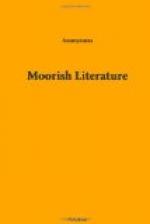Beside the ballads of warlike and amorous adventures, there are sea-songs, songs of captivity, and songs of the galley slave. The Spanish Moor is seized by some African pirate and carried away to toil in the mill of his master on some foreign shore, or he is chained to the rowing-bench of the Berber galley, thence to be taken and sold when the voyage is over to some master who leaves him to weep in solitary toil in the farm or garden. Sometimes he wins the love of his mistress, who releases him and flies in his company.
All these ballads have vivid descriptions of scenery. The towers of Baeza, the walls of Granada, the green vegas that spread outside every city, the valley of the Guadalquivir, and the rushing waters of the Tagus, the high cliffs of Cadiz, the Pillars of Hercules, and the blue waves of the Mediterranean make a life-like background to every incident. In the cities the ladies throng the balconies of curling iron-work or crowd the plaza where the joust or bull-fight is to be witnessed, or steal at nightfall to the edge of the vega to meet a lover, and sometimes to die in his arms at the hands of bandits.
There is a dramatic power in these ballads which is one of their most remarkable features. They are sometimes mere sketches, but oftener the story is told with consummate art, with strict economy of word and phrase, and the denouement comes with a point and power which show that the Moorish minstrel was an artist of no mean skill and address.
The authors of the Moorish romances, songs, and ballads are unknown. They have probably assumed their present literary form after being part of the repertoire of successive minstrels, and some of the incidents appear in more than one version. The most ancient of them are often the shortest, but they belong to the period when southern Spain under Mahometan rule was at the height of its prosperity, and Arabian learning, art, and literature made her rank among the first countries in Europe. The peninsula was conquered by the Moors in the caliphate of Walid I, 705-715 A.D., and the independent dynasty of the Ommiades was founded by Abderrhaman at Granada in 755 A.D. It was from this latter date that the Spanish Moors began to assume that special character in language, manners, and chivalric enthusiasm which is represented in the present ballads; the spirit of Christian knighthood is here seen blended with Arabian passion, impetuosity, and impulsiveness, and the Spanish language has supplanted, even among Mahometan poets, the oriental idiom. We may roughly estimate the period in which the Moorish romance flourished as comprised in the years between 1100 and 1600 A.D.




